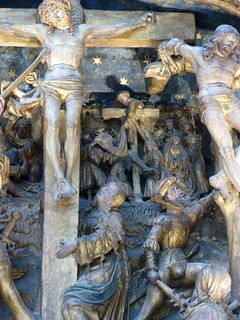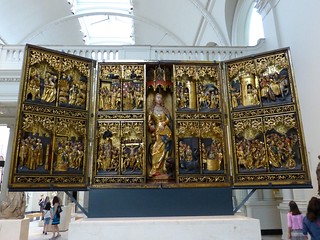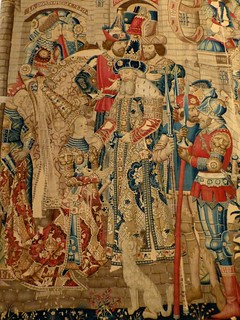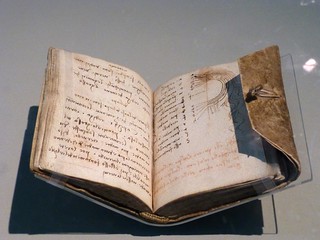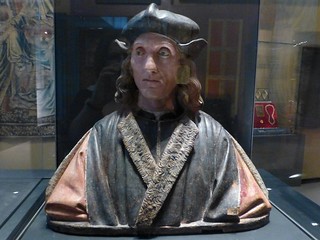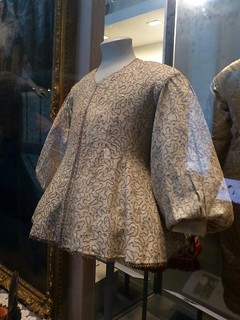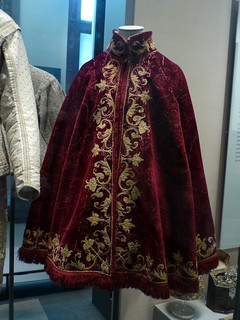Shakespeare and His World was a 10 week course on Future Learn which finished just a couple of weeks ago. The course was run by Warwick University and presented by Jonathan Bate (with Jennifer Waghorn as moderator). And in the 10 weeks it covered a huge amount of ground! Each week focussed on a particular theme and there were 6 or 7 video lectures, each of which featured an object from Shakespeare’s time – most of these were from the collections of the Shakespeare’s Birthplace Trust, and most of the videos were filmed there. And eight of the weeks featured a particular Shakespeare play, which also illustrated the weekly theme. We were looking at both what the plays told us about the time they were written in, and what contemporary events & things influenced the writing of the plays. As well as this we also looked a little at the plays as plays rather than historical items – their themes & characters and so on. Obviously in the time available all of this was covered at a fairly superficial level – an overview rather than anything in depth, but there were normally links to places to find out more about the featured objects and some ideas for further investigating the plays.
Week 1 was an introductory week which looked at what we know of Shakespeare’s life story and also set him in context as an Elizabethan playwright and poet. We also read Venus and Adonis, one of Shakespeare’s poems. The second week was the first one with a play, The Merry Wives of Windsor. The theme was Shakespeare’s time in Stratford, in particular his schooling, and this was a good play to illustrate it because although the town in the play is Windsor there’s internal evidence that suggests Shakespeare was actually basing it on Stratford. And he made use of the sorts of people he would’ve known growing up to provide characters for the play – in particular there’s a small part for a schoolboy called Will which is generally assumed to be an author-insert.
Week 3 used A Midsummer Night’s Dream to focus on the theatre in Elizabethan England – chosen because of the play within a play sequence. Week 4 was about war, using Henry V as the illustrative play. Bate made the point in this week that Shakespeare was a war poet for the first half of his career – England was at war with Spain in this period – so Henry V isn’t just looking back to former glories but is also saying something about contemporary events in particular the defeat of the Armada. Week 5 moved on to look at finance, using the Merchant of Venice. As well as the obvious use of Shylock the moneylender to think about how Elizabethan money & finances worked, we also looked at how Shakespeare often used Venice as a mirror for London. And of course we also covered Elizabethan attitudes to Jews, as well as looking at how Shylock has been portrayed through the ages since the play was written. Shakespeare himself seems to be making a more nuanced point than some later stagings of the play.
I’m afraid this is turning into a bit of a laundry list, but I’m trying not to go into too much detail otherwise this post will go on forever!
Week 6 used Macbeth to look at witches and medicine. Because of studying the play at school around 25 years ago I was expecting the bits about witches, but I hadn’t really thought about what the play tells us about medicine of the time before. Sadly the discussion section for this week (about similarities and differences between modern & 16th Century medicine) got over-run by people enthusing over herbal remedies being better than “all those chemicals” and misplaced nostalgia so I stopped reading it before my blood pressure rose too much. The seventh week used Othello to look at the interactions between Christendom and the Islamic world. Again Shakespeare is more nuanced than some later stagings of the play – the villain of the play, after all, is Iago who is a white Christian (although notably with a Spanish name). Othello the Moor is basically a good man who is led astray by Iago’s playing on his insecurities.
The eighth week looked at what Classical culture meant to the people of Shakespeare time, and also to look at how “the East” was regarded. The illustrative play chosen was Anthony and Cleopatra which obviously gives us an image of orderly moral Rome vs the opulent decadence of Egypt. And it was also a play designed to appeal to James VI & I by implying he occupies the place of Augustus in his own time, seen in the play as unifier and peacemaker. Week 9 was the last week with a play – fittingly this was The Tempest, Shakespeare’s last solo authored play. This was used to illustrate the “Brave New World” of the Americas that the Stuart age was beginning to successfully colonise. And also to think about how the art of the theatre was similar to the art of magic in The Tempest so Prospero’s final speech retiring from his art can be seen as Shakespeare’s final speech too. And the last week was a brisk trot through Shakespeare’s legacy looking at how he grew from being regarded as one of the Elizabethan playwrights into “the Greatest Playwright of All TIme”.
I’m glad the information, including videoes & links, is still available on Future Learn for those of us that did the course – I’m not sure I got everything out of the course that I could and some weeks I definitely skimped on due to lack of time. Even tho by the end I was thinking it had out stayed its welcome a bit (8 plays in 8 weeks is a lot to read and contemplate) I’m glad I did it 🙂

